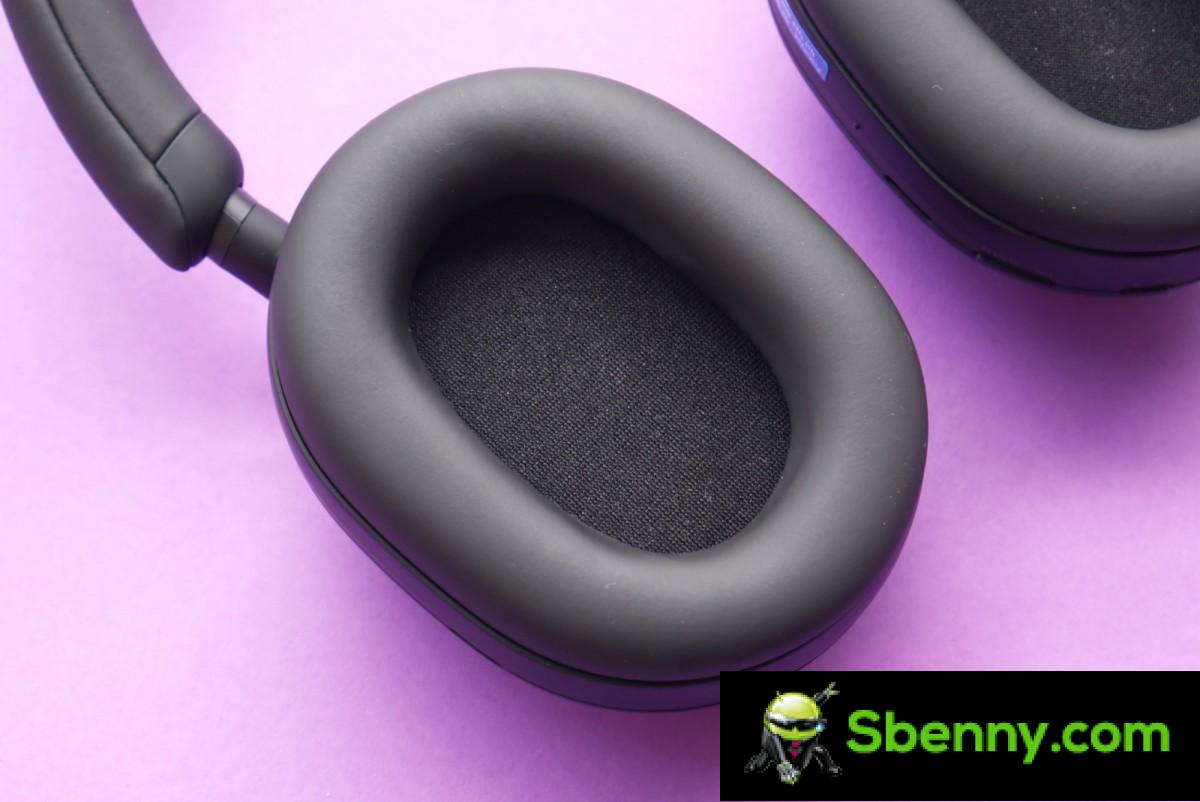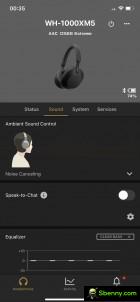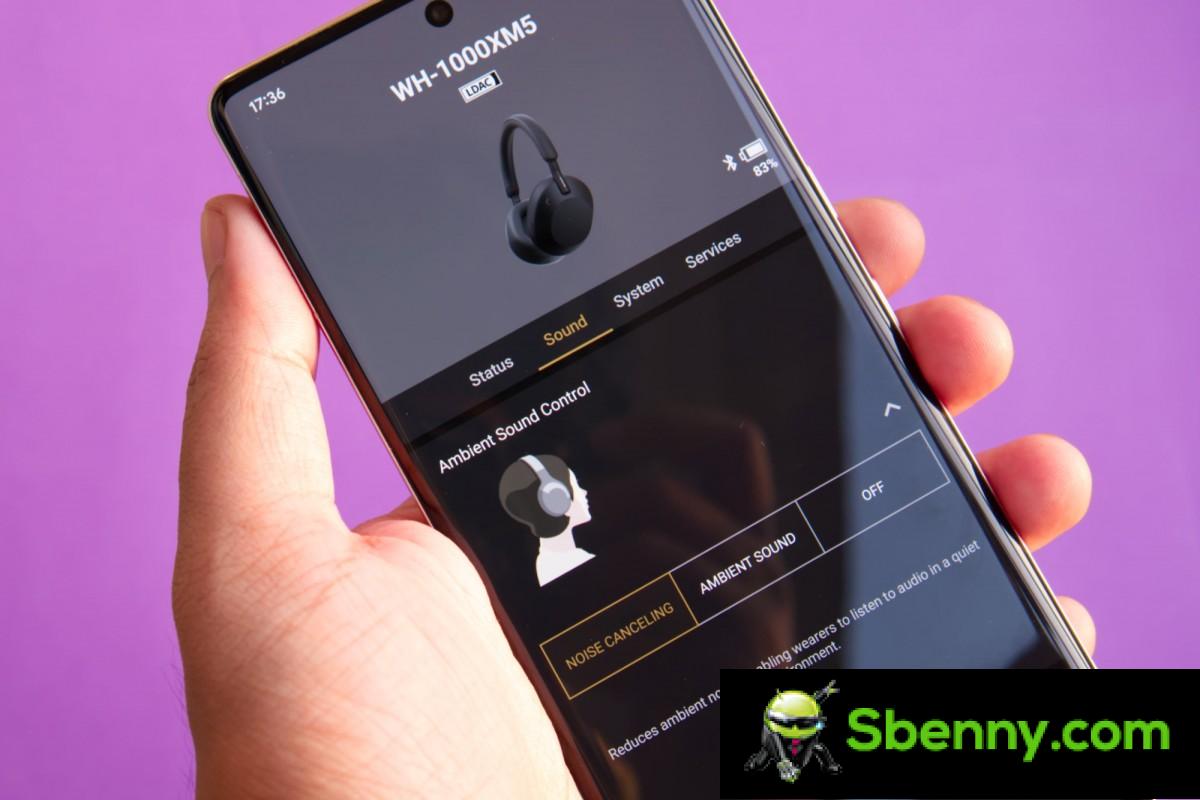Sony’s ridiculously named WH-1000X series was a huge success. The original model launched in 2016 and had the tough battle of going against the industry standard that was Bose. While the first model has shown promising results, it’s been the continuous iterations over the years that solidified Sony’s position in the segment and helped it win the crown for the most effective noise cancellation on the market.

Several years have passed since then and the market has matured a lot. The latest generation WH-1000XM5 enters a more crowded arena, with the likes of Bose, Apple, Sennheiser, Beats, B&O, JBL and AKG, all holding Sony’s neck at both ends of the band. price. Does the new model have what it takes to remain competitive in this market? It’s time to find out.
Design and comfort
The WH-1000XM5 shows the first major redesign for the series, which until now has only had iterative changes. The bulky yokes and thick headbands of previous generations paved the way for an agile and delicate design.

The pavilions, which still retain the characteristic flattened dome shape, are now suspended directly from the arch, which ends in a single point of contact. The hinge for the attachment is hidden and allows for vertical rotation. The ear cups can also rotate sideways in either direction, although they can only remain flat facing outward from the wearer.
The headband now also features a continuous slider for length adjustment. Personally I’m not a fan of this as it makes it impossible to have a perfectly uniform length on both sides, but those with a less obsessive-compulsive disposition wouldn’t think about it.



The case…
A disadvantage of the new design is that the earpads no longer fold inward inside the headband as in previous models. This results in a somewhat larger bezel for the headphones, which therefore requires a larger case. It’s not dramatically larger than the previous case’s design, but it’s still more free space you can do without on the go. The case flattens to half its thickness when empty so you can save space in at least one size.


… is foldable
Returning to the headphones, the ear cups are littered with ports on the sides for the four microphones placed on each side. The left earcup has buttons to turn on or pair the headphones and another to change ANC modes. There is also a port for connecting the analog audio cable. The right earcup has a USB-C charging port, which can’t be used for audio like on the Shure Aonic 50. The right earcup also supports gestures, but more on that later.
The earpads are padded with leather-covered foam. The speaker grille also has thick foam padding covering it. The proximity sensor visible on the WH-1000XM4 has been replaced with a more hidden sensor under the pad.

Comfort on the WH-1000XM5 was mediocre to my ears. While the cushions are soft and fit comfortably in your head, the earpads don’t have enough depth to prevent the padding on the speaker grille from pressing against your ears. I have quite sensitive ears and it was impossible for me to wear these headphones for more than a couple of hours straight, and fatigue would have increased much sooner. And as is the case with all ANC headphone cushions, breathability is non-existent, so your ears tend to boil in their own sweat in warmer climates.
While the situation can be solved with aftermarket ear cushions – Dekoni already has deeper ear cushions in development for the WH-1000XM5 – this comes at the expense of changes in audio performance and the reduction in the effectiveness of active noise cancellation. If you already own these headphones and are having trouble with comfort, this is something you can look into.
In terms of build quality, the WH-1000XM5s are well made. Although the exterior is almost entirely made of plastic, everything has a luxurious soft feel to the touch. The moving parts also have a well-damped feel with smooth actuation. The only drawback of all matte black plastic is that it gets covered in oil and stains skin and hair very easily.

As with most other noise canceling headphones designed for travel, the WH-1000XM5 are not water resistant. I don’t anticipate this to be an issue for their intended use case nor do I think it’s a requirement for this class of headphones, but if it’s something that’s important to you, you should consider purchasing in-ear models. Or an umbrella.
Software and features
The WH-1000XM5 are compatible with the same proven Sony Headphones Connect app used for all Sony headphones. The app has gained a lot of features over the years (depending on the headphones connected) but, unfortunately, it has also become quite laborious to set up. Just look at the time and process it takes to enter the app home screen after installing the app.
Once you get past all of that, the main app UI should be familiar to anyone who has used Sony headphones in the past. From the home screen, you can control the adaptive sound control function and also the playback of the music currently playing. The second section is where all audio related features are adjusted, including ANC, EQ, 360 Reality Audio setup and DSEE Extreme. The third section allows you to control the various button presses and gestures.
Here’s a quick rundown of some of the features found here. Adaptive Sound Control detects your movements and position and adjusts the ANC accordingly. The Talk to Chat feature will detect when you start talking and lower the volume, as well as enable Ambient Sound Mode.
360 Reality Audio is Sony’s simulated surround sound feature, which only works with mastered content. You need to set it up first, which involves scanning your ears so it can create a head-related transfer function for you, then customize the sound accordingly. Then you can install the profile created for one of the compatible apps that offer content in this format, which includes Amazon Music, Tidal, Deezer, nugs.net, and PeerTracks.
As none of these are available in my region, there was no way for me to test this feature with the WH-1000XM5. However, I’ve used it previously with a different pair of Sony headphones, and the effect isn’t much different from using Dolby Atmos on most other headphones these days.








Connect Sony headphones
Sony also has its DSEE Extreme, which is Sony’s AI-based audio reconstruction technology designed to restore lost detail in compressed music. While it should work on low bit rate sources, it only works when using SBC or AAC on headphones and not LDAC. This means that it is apparently restoring the lost data from Bluetooth compression and not inside the original audio file. Either way, it doesn’t seem to do much.
Sony also has an equalizer built into the app, which features 5 bands and a Clear Bass slider, which essentially serves as the sixth band. There are also custom presets for saving your settings, as well as preset audio profiles. All testing here was performed with EQ and DSEE Extreme disabled.
As mentioned above, the headphones support touch-based gestures on the right ear cup. While this may seem commonplace these days, it was quite unique in 2016 when the WH-1000X debuted with it.
The gestures work pretty much as you would expect. Double tap to play / pause, swipe back and forth to skip to the next and previous Sony, and swipe up and down to increase and decrease the volume. Gestures work well and over the years it has become less foolish to tickle headphones in public. It’s just a shame that the gestures only work on one side so you’re forced to use your right hand to use them.
The app also includes Spotify Tap, which allows you to launch the app and start playing by assigning it one of the buttons.

Like the previous generation model, the WH-1000XM5 are able to automatically pause and play when the headphones are removed or put on. They can also turn off automatically after some time if you don’t wear them. However, my unit had a hard time understanding when they were removed from the head and the audio often kept playing for a long time or sometimes never stopped.
My understanding is that the new sensor buried under the foam somewhere on the right side of the left ear cup often gets covered by the compressed ear cup and has a hard time figuring out when it’s not blocked by a real ear. When the headset was manually disassembled, the headphones stopped well. I’m not sure how prevalent this problem is on retail units.
Finally, the WH-1000XM5 supports multipoint connection, which allows you to pair them to two devices at the same time. It mostly works as you’d expect and you even see the two devices within the app. The only problem is that you have downgraded to SBC or AAC on both devices and LDAC is not available.
Performance
Audio quality
The WH-1000XM5 has 30mm single dynamic drivers, which are smaller than the WH-1000XM4’s 40mm drivers but made with a softer rim and stiffer carbon fiber composite dome. Aside from that, the headphones support SBC, AAC and LDAC codecs over a Bluetooth 5.3 connection.
The WH-1000XM5s have lackluster audio quality for a premium pair of headphones. It’s the same kind of hollow, low-pitched sound the series is known for and there hasn’t been any noticeable improvement on that front.
The sound is dominated by a large bass shelf that covers the low and mid regions, spilling out into the low-mid range. This unrefined and indiscriminate approach to bass boost causes all sounds in the lower regions of the audio spectrum to have a muddy, lumpy quality that feels heavy to hear. It also washes the low-mid range, which then takes on a booming tone as well, affecting male vocals and making them sound congested.
The mid-high range is thankfully spared from this and generally sounds pretty decently. While it can’t compensate for the distorted timbre and cloudy vocals, the instruments and female vocals at least have a good presence in the mix and aren’t smothered in the background.
Lower treble performance is also decent, which helps instruments such as cymbals and vocal upper harmonics, including the “s” and “t” sounds, sound thicker. The upper highs roll off aggressively and sound rather muffled. This results in a decrease in air frequencies, which gives the entire audio spectrum a dark, boxed tone.

The result is audio that doesn’t sound natural. If you’re used to headphones with more balanced, higher quality sound, the WH-1000XM5 sound congestion feels claustrophobic. It feels compressed to a very narrow band of the audible frequency spectrum, most of which consists of swollen bass and mid-bass. After a few minutes of listening, your ears are asking for a more articulate treble response or at least a semblance of detail and clarity in the sound. Also, while the imaging performance is good, the sound stage is poor.
The sound can be improved to some extent with judicious use of equalization within the app, starting with reducing the Clear Bass setting. This can improve tonality but cannot compensate for the lack of resolution or detail on the part of the drivers, which again are lackluster. Simply connect the headphones with the supplied cable and use them in the off mode to hear how the drivers actually sound without the aid of digital signal processing. It’s the stuff of nightmares.
My genuine belief regarding the WH-1000X series is that Sony has never prioritized audio quality and that the focus has always been on ANC performance. Sony is quite capable of producing good quality headphones when they want, but they don’t believe it’s necessary for their more traditional products or prefer to spend those resources elsewhere.
Incidentally, almost all competitors have better handling of this situation. Both Bose and Apple have far superior tuning for their competing headphones, and even relatively smaller brands like JBL and AKG have some absolute gems in their lineup that will outperform almost any mainstream Sony headphones. My expectation with the WH-1000XM5 was that Sony would finally care about audio quality in the face of stiff competition, but it didn’t.
Microphone
The Sony WH-1000XM5 has good microphone performance. In an ideal, quiet room, voice quality is good by the standards of Bluetooth headphones with clear, pleasing tones but lacks the natural tone and fullness of wired and non-Bluetooth wireless headphones. Voices are still mostly forward and could use more detail in the higher frequencies. For voice calls, this is not a problem as your callers can still hear you clearly.
In noisy environments, the noise reduction algorithm works very well; some of the recordings I made in a noisy environment may pass as having been recorded in a quiet room. The only difference is that my voice sounded a little lower than when recording in a quiet room. Your callers may not even realize that you are outdoors.
The only problem with recordings regardless of where they were made was persistent background noise being added by the headphones. It’s quite unmistakable and plagues every call or recording you make, so it never feels like you’re in a completely silent environment. This is most likely something Sony could fix with a software update or it could also be a problem with my drive.
Noise cancellation
The WH-1000XM5 has good noise cancellation performance. They provide complete cancellation of background noise across the frequency spectrum, something cheaper models often struggle with. The earpads themselves block out a lot of mid- and high-frequency noise and thus the ANC activates and gets rid of even the lower frequencies.
Of course, I haven’t done a full test of these headphones in all environments. In particular, I have not been able to do any tests on an aircraft and cannot report how well they would work for frequent travelers. Also, I didn’t have the previous generation WH-1000XM4 or any of the competing headphones on hand to compare.

A notable change with the WH-1000XM5 from its predecessors is that the ANC can no longer be manually adjusted by the user. The WH-1000XM5 automatically dials the amount of noise reduction based on the surrounding environment. I’m not sure if this is a battery-saving measure or if Sony truly believes its algorithm is foolproof. I had no reason to criticize the system as it always worked as expected in my test environments, but I have heard reports from users complaining that it was not consistent or not as effective as the previous generation model.
The ANC has improved somewhat over the WH-1000XM4. The WH-1000XM4 occasionally reproduced just random background noise through the speakers, such as the sound of an airplane flying overhead, which seemed to defeat the purpose of the ANC. There would also be the occasional flickering of sound when ANC was on while wearing headphones or moving around them. In comparison, the WH-1000XM5 ANC was rock solid and always performed as intended.
Finally, the ambient sound mode also works quite well. Sony either doesn’t aim for natural sound or can’t achieve it unlike Apple, but the result is less accurate and more functional sound. If you just want to briefly hear about things around you, it works quite well. If you want to walk around with it enabled and want to feel like you’re not even wearing headphones, this just doesn’t reach it.
Latency
The WH-1000XM5 has good latency performance for watching videos. The delay is mostly unnoticeable and in most cases indistinguishable from using wired headphones. It’s also adequate for casual gaming, although you may still want to use wired headphones for competitive gaming, especially if you plan on using voice chat.
Connectivity
The WH-1000XM5 had decent connectivity performance. For the most part, there have been no dropped connections, although there have been a few instances where the sound stutters or skips a bit forward when listening to music. This also happened with the source device at a safe distance, so it wasn’t a long distance or obstacles causing interruptions.
Battery life
The WH-1000XM5 has a claimed battery life of 30 hours with ANC enabled. Sony does not explain if this is using SBC / AAC or LDAC and in the past I have found that the claim was mostly about using SBC / AAC. So, once again, I decided to test both.
When using AAC, the headphones played for 31 hours and 50 minutes, which is way beyond the official claim. By switching to LDAC and manually locking it at 990 kbps, I got 29 hours and 53 minutes, which is very close to the official claim and also surprisingly close to the AAC figure. The WH-1000XM4, for reference, had a 10 hour difference in its AAC and LDAC figures.
Sony also claims that a 3-minute charge will provide 3 hours of use. Testing with AAC I got 4 hours and 24 minutes, and with LDAC I got 3 hours and 40 minutes, so a whole lot more either way.
From previous experiences with Sony headphones, I also know that the DSEE function significantly reduces battery life. However, in the interest of time, I was unable to run a test with this feature enabled. Also, I didn’t test with ANC disabled as it didn’t make much sense to test in this mode.
Conclusion
The Sony WH-1000XM5 are a good pair of noise canceling headphones for those who spend a lot of time outdoors or on the go. Active noise cancellation continues to be a strong point of this series, and coupled with the good microphone performance and long battery life, I was happy enough to use them outdoors.

What I was not satisfied with was the audio quality for critical listening. The sound is perfect for outdoor use, but at home it was easy to notice all the pitfalls compared to even much cheaper wired headphones. If you just want to listen to something at home, I recommend a good pair of wired headphones instead, like the HiFiMan Sundara or the Sennheiser HD 560S.
Even among its wireless peers, the WH-1000XM5 is at the bottom, as those who want to focus and enjoy their music would be better served by the Bose 700, AirPods Max, or Sennheiser Momentum 4. Or they could spend a lot less and grab a couple of. AKG K371BT and give almost all of these more expensive models a run for their money. It doesn’t help that the WH-1000XM5s aren’t particularly comfortable for prolonged listening either, at least to my ears.
Overall, the WH-1000XM5 are good travel headphones, but if you’re looking for just one pair of headphones for all your needs, you should look elsewhere.







Start a new Thread